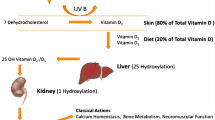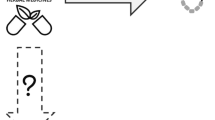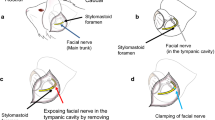Abstract
Roles of vitamin D on the immune and nervous systems are increasingly recognized. Two previous studies demonstrated that ergocalciferol (vitamin D2) or cholecalciferol (vitamin D3) induced functional recovery and increased myelination in a rat model of peroneal nerve transection. The current report assessed whether cholecalciferol was efficient in repairing transected rabbit facial nerves. Animals were randomized into two groups of rabbits with an unilateral facial nerve surgery: the vitamin D group included animals receiving a weekly oral bolus of vitamin D3 (200 IU/kg/day), from day 1 post-surgery; the control group included animals receiving a weekly oral bolus of vehicle (triglycerides). Contralateral unsectioned facial nerves from all experimental animals were used as controls for the histological study. The facial functional index was measured every week while the inner diameter of myelin sheath and the G ratio were quantified at the end of the 3 month experiment. The current report indicates that cholecalciferol significantly increases functional recovery and myelination, after 12 weeks of treatment. To the best of our knowledge, this is the first study investigating the therapeutic benefit of vitamin D supplementation in an animal model of facial paralysis. It paves further the way for clinical trials based on the administration of this steroid in individuals with injured facial nerves.




Similar content being viewed by others
References
Fisch U (1980) Management of intratemporal facial nerve injuries. J Laryngol Otol 94(1):129–134
Johnson F, Semaan MT, Megerian CA (2008) Temporal bone fracture: evaluation and management in the modern era. Otolaryngol Clin North Am 41(3):597–618
Davis RE, Telischi FF (1995) Traumatic facial nerve injuries: review of diagnosis and treatment. J Craniomaxillofac Trauma 1(3):30–41
Langhals NB, Urbanchek MG, Ray A, Brenner MJ (2014) Update in facial nerve paralysis: tissue engineering and new technologies. Curr Opin Otolaryngol Head Neck Surg 22(4):291–299
Roh J-L, Park CI (2008) A prospective, randomized trial for use of prednisolone in patients with facial nerve paralysis after parotidectomy. Am J Surg 196(5):746–750
Karlidag T, Yildiz M, Yalcin S, Colakoglu N, Kaygusuz I, Sapmaz E (2012) Evaluation of the effect of methylprednisolone and N-acetylcystein on anastomotic degeneration and regeneraton of the facial nerve. Auris Nasus Larynx 39(2):145–150
Vilela DSA, Lazarini PR, Da Silva CF (2008) Effects of hyperbaric oxygen therapy on facial nerve regeneration. Acta Otolaryngol (Stockh) 128(9):1048–1052
Toros SZ, Karaca ÇT, Güneş P, Oysu Ç, Ertugay ÇK, Naiboğlu B et al (2013) Hyperbaric oxygen versus steroid in facial nerve injury: an experimental animal study. Am J Otolaryngol 34(5):530–536
Kohmura E, Yuguchi T, Yoshimine T, Fujinaka T, Koseki N, Sano A et al (1999) BDNF atelocollagen mini-pellet accelerates facial nerve regeneration. Brain Res 849(1–2):235–238
Jones KJ (1993) Recovery from facial paralysis following crush injury of the facial nerve in hamsters: differential effects of gender and androgen exposure. Exp Neurol 121(1):133–138
Costa HJZR, da Silva CF, Costa MP, Lazarini PR (2007) Evaluation of the systemic use of riluzole in post-traumatic facial nerve regeneration: experimental study in rabbits. Acta Otolaryngol (Stockh) 127(11):1222–1225
Scheller K, Scheller C (2012) Nimodipine promotes regeneration of peripheral facial nerve function after traumatic injury following maxillofacial surgery: an off label pilot-study. J Craniomaxillofacial Surg 40(5):427–434
Makoukji J, Belle M, Meffre D, Stassart R, Grenier J, Shackleford G et al (2012) Lithium enhances remyelination of peripheral nerves. Proc Natl Acad Sci USA 109(10):3973–3978
de Souza Euler, Lucena E, Guzen FP, de Paiva Lopes, Cavalcanti JR, Galvão Barboza CA, Silva do Nascimento Júnior E, Cavalcante J de S (2014) Experimental considerations concerning the use of stem cells and tissue engineering for facial nerve regeneration: a systematic review. J Oral Maxillofac Surg 72(5):1001–1012
Smolders J, Moen SM, Damoiseaux J, Huitinga I, Holmøy T (2011) Vitamin D in the healthy and inflamed central nervous system: access and function. J Neurol Sci 311(1–2):37–43
Fernandes de Abreu DA, Eyles D, Féron F (2009) Vitamin D, a neuro-immunomodulator: implications for neurodegenerative and autoimmune diseases. Psychoneuroendocrinology 34(Suppl 1):S265–S277
Chabas J-F, Alluin O, Rao G, Garcia S, Lavaut M-N, Risso JJ et al (2008) Vitamin D2 potentiates axon regeneration. J Neurotrauma 25(10):1247–1256
Chabas J-F, Stephan D, Marqueste T, Garcia S, Lavaut M-N, Nguyen C et al (2013) Cholecalciferol (vitamin D3) improves myelination and recovery after nerve injury. PLoS One 8(5):e65034
McCoy EG, Boyle WF (1971) Reinnervation of the facial muscles following extratemporal facial nerve resection. Laryngoscope 81(1):1–7
Spector JG, Lee P, Derby A (2000) Rabbit facial nerve regeneration in autologous nerve grafts after antecedent injury. Laryngoscope 110(4):660–667
Costa HJZR, da Silva CF, Korn GP, Lazarini PR (2006) Posttraumatic facial nerve regeneration in rabbits. Braz J Otorhinolaryngol 72(6):786–793
Savastano LE, Laurito SR, Fitt MR, Rasmussen JA, Gonzalez Polo V, Patterson SI (2014) Sciatic nerve injury: a simple and subtle model for investigating many aspects of nervous system damage and recovery. J Neurosci Methods 227C:166–180
Wergeland S, Torkildsen O, Myhr K-M, Aksnes L, Mork SJ, Bo L (2011) Dietary vitamin D3 supplements reduce demyelination in the cuprizone model. PLoS One 6(10):e26262
Cornet A, Baudet C, Neveu I, Baron-Van Evercooren A, Brachet P, Naveilhan P (1998) 1,25-Dihydroxyvitamin D3 regulates the expression of VDR and NGF gene in Schwann cells in vitro. J Neurosci Res 53(6):742–746
Brown J, Bianco JI, McGrath JJ, Eyles DW (2003) 1,25-dihydroxyvitamin D3 induces nerve growth factor, promotes neurite outgrowth and inhibits mitosis in embryonic rat hippocampal neurons. Neurosci Lett 343(2):139–143
Eyles D, Almeras L, Benech P, Patatian A, Mackay-Sim A, McGrath J et al (2007) Developmental vitamin D deficiency alters the expression of genes encoding mitochondrial, cytoskeletal and synaptic proteins in the adult rat brain. J Steroid Biochem Mol Biol 103(3–5):538–545
Marchesi C, Milani M, Morbin M, Cesani M, Lauria G, Scaioli V et al (2010) Four novel cases of periaxin-related neuropathy and review of the literature. Neurology 75(20):1830–1838
Terada N, Baracskay K, Kinter M, Melrose S, Brophy PJ, Boucheix C et al (2002) The tetraspanin protein, CD9, is expressed by progenitor cells committed to oligodendrogenesis and is linked to beta1 integrin, CD81, and Tspan-2. Glia 40(3):350–359
Zhao C, Fancy SPJ, ffrench-Constant C, Franklin RJM (2008) Osteopontin is extensively expressed by macrophages following CNS demyelination but has a redundant role in remyelination. Neurobiol Dis 31(2):209–217
Cantorna MT (2006) Vitamin D and its role in immunology: multiple sclerosis, and inflammatory bowel disease. Prog Biophys Mol Biol 92(1):60–64
Yildiz M, Karlidag T, Yalcin S, Ozogul C, Keles E, Alpay HC et al (2011) Efficacy of glial growth factor and nerve growth factor on the recovery of traumatic facial paralysis. Eur Arch Otorhinolaryngol 268(8):1127–1133
Dellon AL, Mackinnon SE (1989) Selection of the appropriate parameter to measure neural regeneration. Ann Plast Surg 23(3):197–202
Vieth R (2004) Why the optimal requirement for Vitamin D3 is probably much higher than what is officially recommended for adults. J Steroid Biochem Mol Biol 89–90(1–5):575–579
Kobayashi S, Koyama J, Yokouchi K, Fukushima N, Oikawa S, Moriizumi T (2003) Functionally essential neuronal population of the facial motor nucleus. Neurosci Res 45(3):357–361
Acknowledgments
Our grateful thanks to Collège Français des enseignants d’Otorhinolaryngologie et Chirurgie Cervico-Faciale and Fondation de l’Avenir for their support, and to Béatrice Fiorenza for her gracious help with the Fig. 1.
Conflict of interest
The authors declare that they have no conflict of interest concerning this article.
Author information
Authors and Affiliations
Corresponding author
Additional information
J.-P. Lavieille and F. Feron are equally supervising authors.
Rights and permissions
About this article
Cite this article
Montava, M., Garcia, S., Mancini, J. et al. Vitamin D3 potentiates myelination and recovery after facial nerve injury. Eur Arch Otorhinolaryngol 272, 2815–2823 (2015). https://doi.org/10.1007/s00405-014-3305-y
Received:
Accepted:
Published:
Issue Date:
DOI: https://doi.org/10.1007/s00405-014-3305-y




